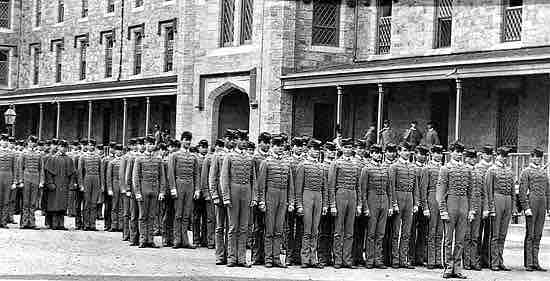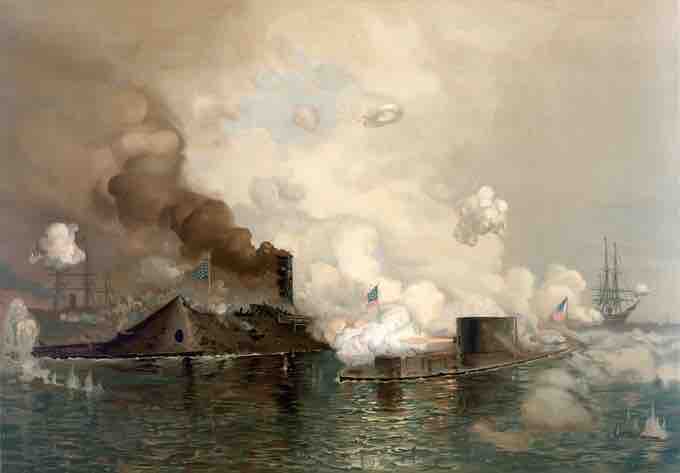Overview
The American Civil War is often referred to as the "first modern war" due to an unprecedented mobilization of the civilian base in both Union and Confederate territory, and because it was hallmarked by technological innovations that changed the nature of battle. Some of the innovations and advances of the Civil War included new developments in medicine, communication, transportation, and weaponry.
Innovations in Communication and Transportation
Several communication and transportation improvements, including the telegraph and railroads, played a crucial role in this war. The telegraph allowed leaders in Washington and Richmond, the respective capitals of the Union and Confederacy, to communicate with commanders in the field, rapidly passing on intelligence and issuing orders in close to real time. By 1860, approximately 30,000 miles of railroad track, concentrated in the Northern states, reduced dependence on local farms and cities for supplies. Armies were thus able to operate for extended periods of time without fear of starvation. The mobility of forces also was greatly increased, as rather than marching, armies could be moved across the country within days by rail.
Innovations in Weaponry
Weaponry also changed significantly during the Civil War. The most lethal change during the Civil War was the introduction of rifling to muskets. In previous wars, the maximum effective range of a musket was between 70 to 110 meters. Tactics involved moving masses of troops to musket range, firing a volley, and then charging the opposing force with the musket's bayonet. However, a bullet from an aimed rifled musket could hit a soldier more than 1,300 meters away. This drastically changed the nature of warfare to the advantage of defenders.

Nineteenth-century rifled musket
The use of rifles on the battlefield greatly increased casualties in the Civil War.
In terms of defensive fortification, wire obstacles—defensive obstacles constructed using barbed wire or concertina wire—are thought to have originated with Union General Ambrose Burnside during the Battle of Fort Sanders during the Knoxville Campaign. During that battle, telegraph wire was seen strung between tree stumps 30 to 80 yards in front of parts of the Union line. At sea, the greatest innovation was the introduction of ironclad warships, which was facilitated by the development of heavy naval guns, more sophisticated steam engines, and advances in metallurgy that made steel shipbuilding possible. Ironclads were designed for multiple purposes, serving as high-seas battleships, coastal defense ships, and long-range cruisers.
Innovations also took place in air warfare. The Union Army Balloon Corps was established and organized by Professor Thaddeus S.C. Lowe during the summer of 1861, marking the first major-scale use of balloons in the military. The Balloon Corps devised a more efficient way of inflating the balloons during this time, substituting coal gas—which required the balloon to be inflated in a municipal-services center, walked out to the battlefield, and then returned within four days for reinflation—with hydrogen gas generators, which proved to be more compact and transportable. Initially the balloons were intended to aid in mapmaking; however, they were quickly co-opted for use in aerial reconnaissance. Though the balloons were useful in some battles, such as those of the Peninsula Campaign, military attitude shifted away from the use of balloons over time, and by August 1863, the Union Balloon Corps was disbanded. The Confederate Army also delved into ballooning during the Civil War, but was ultimately limited by shortage of supplies due to embargoes in place against the Confederacy.
Military Education and the Creation of the U.S. Military and Naval Academies
These new technologies required new tactics to effectively wage war; thus, professional military education was also revolutionized during the Civil War. The United States Military Academy at West Point and the United States Naval Academy at Annapolis created dedicated cadres of professional officers with strong backgrounds in military science. The legacy helped forge the traditions of the modern U.S. officer corps of all service branches.

West Point cadets, ca. 1870
Training and the development of military science at the United States Military Academy at West Point played an important role in the Civil War.
In terms of medical practice during the war, a new medicinal wing was created in the Union under the jurisdiction of a "Medical Director of the Army." The first field hospitals, small tents with a few tables or beds for the wounded, were developed, and a system of transport of the wounded to general hospitals was created. The Confederacy generally had a less established medical service as a result of its more limited resources, vast rural areas, and fewer medical professionals.

The Monitor and the Merrimac, lithograph from 1886
The engagement between the Monitor and the Merrimac was the first engagement between ironclad warships in the Civil War.